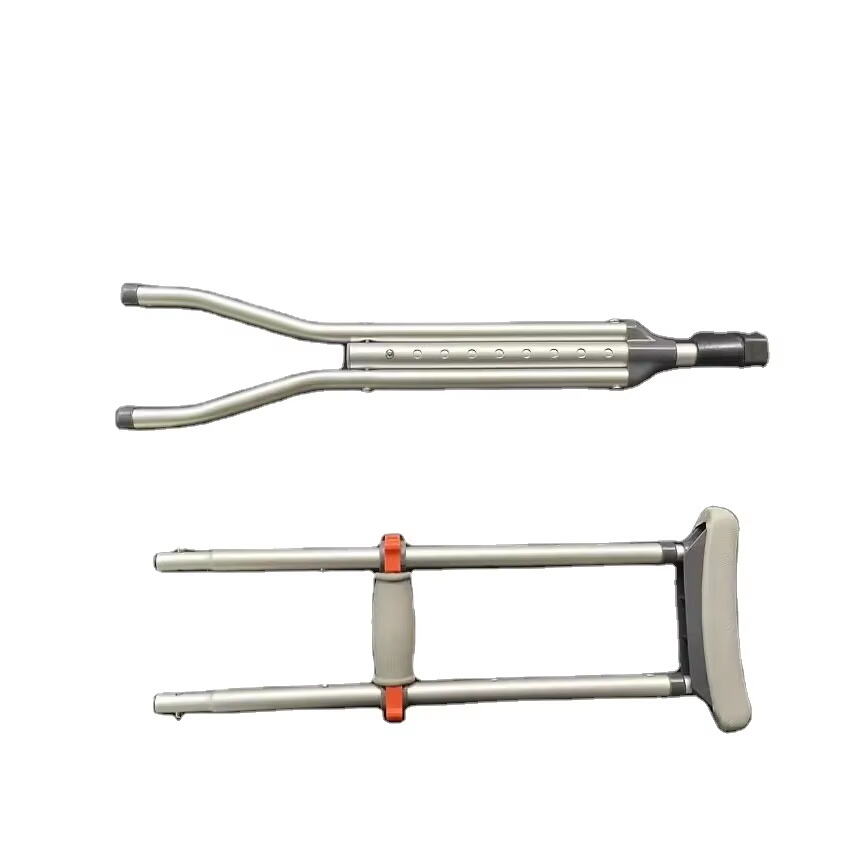The Importance of Proper Under Arm Crutch Maintenance
Maintaining under arm crutches is essential for both user safety and compliance with health regulations. Proper maintenance ensures that crutches remain reliable and safe, significantly reducing the risk of injury. For instance, regular checks for wear and tear on components such as pads and grips can prevent accidents due to slippage or breakage. Furthermore, a well-maintained crutch is less likely to contribute to improper posture or falls, which supports better rehabilitation outcomes.
Regular maintenance also extends the lifespan of under arm crutches, offering greater value for the investment made. It's crucial to periodically inspect and adjust crutch settings to match any changes in user's height or requirements, ensuring continued comfort and efficiency. Studies have indicated that users employing well-kept assistive devices experience fewer injuries and complications. Therefore, keeping under arm crutches in optimal condition not only protects users but also maximizes the device's functionality and longevity.
Daily Cleaning and Hygiene Practices for Under Armpit Crutches
Daily Wipe-Down Routine for Bacteria Control
Keeping under armpit crutches clean is essential to preventing bacteria buildup. I follow a simple daily routine using disinfectant wipes or a solution containing 70% isopropyl alcohol. This routine focuses on common touchpoints such as handles and armrests. As recommended by the CDC, it is crucial to clean frequently touched surfaces daily to minimize infection risks.
Deep Cleaning Techniques for Stubborn Residue
For a more thorough clean, soaking cloths in warm soapy water and scrubbing the crutch components, especially where dirt collects, is effective. I use a soft brush for hard-to-reach crevices to ensure all residues are removed. Experts suggest performing a deep clean on a monthly basis to enhance hygiene and maintain crutch functionality, avoiding residue buildup that might compromise the integrity of the crutches.
Preventing Odors with Disinfectant Solutions
Odors can arise from sweat and bacteria accumulation, making disinfectant solutions a necessity. After cleaning, I apply a spray to neutralize any odors effectively. Research indicates that using environmental steam cleaners can successfully eliminate odors while being gentle on the crutch materials, providing a fresh and pleasant scent without damage to the crutch surfaces.
Inspecting for Wear and Tear: Key Components to Check
Padding and Cushion Integrity Checks
Regular inspection of the cushioning on under armpit crutches is essential for identifying wear and tear, such as thinning or cracks, which can compromise comfort and safety. The integrity of the padding is crucial as it directly affects user comfort and can prevent skin abrasions. Good padding helps distribute pressure evenly, reducing the likelihood of pressure-related injuries during extended use. Ensuring the crutches have effective cushioning not only enhances comfort but also supports overall health by reducing potential injury risks.
Handle and Grip Degradation Assessment
Handles and grips of crutches play a pivotal role in user comfort and control, and they should be inspected regularly for signs of degradation, such as smoothness loss or wear. An ergonomic grip can significantly enhance the crutch user experience by providing better control and comfort. Studies have shown that a significant number of crutch users experience discomfort due to degraded handles, which can lead to improper usage and exacerbated health issues. Replacing grips when they show signs of degradation is a proactive way to maintain user safety and ease of use.
Tip and Ferrule Replacement Guidelines
Inspecting the rubber tips and ferrules of crutches is crucial for maintaining stability and ensuring safety. These components are prone to wear, and any visible cracks or missing pieces can compromise crutch traction. To uphold stability and traction, it is advisable to replace tips and ferrules every 6 to 12 months, depending on the frequency and manner of use. The replacement of worn-out tips is a simple yet effective measure that can greatly influence crutch reliability and user safety. By adhering to these guidelines, users can ensure their crutches function optimally and continue to provide necessary support.
Adjusting Under Arm Crutches for Optimal Comfort
Height Adjustment: Elbow Bend and Axillary Gap
Proper height adjustment is crucial for comfortable and effective use of under arm crutches. Ideally, crutches should be adjusted to allow for a slight elbow bend of 15-30 degrees and maintain a 2-inch gap between the axilla (armpit) and the top of the crutch, ensuring they're neither too short nor too long. Incorrect height settings can result in discomfort and even increase the risk of falls, as highlighted in health guidelines. It's important to take the time to find the precise fit for your body to optimize both safety and mobility.
Proper Grip Positioning to Avoid Nerve Pressure
Maintaining proper grip positioning is essential to avoid nerve pressure and possible damage, such as crutch palsy. To ensure safety and comfort, crutches should be gripped firmly but without excessive pressure that could stress the nerves. User education on correct hand positioning is important to mitigate these risks. Health organization resources often emphasize that poor hand positioning can lead to significant nerve pressure syndromes, underscoring the value of proper grip for long-term crutch users.
Weight Distribution Tips to Prevent Fatigue
Proper weight distribution while using crutches can significantly prevent fatigue and discomfort during extended use. Leaning slightly forward while effectively utilizing the handgrips can ease strain on the arms. Fitness experts recommend regularly reassessing your technique, especially if you've been using crutches for a long time, to maintain comfort and mobility. Subtle adjustments can make a substantial difference in preventing early fatigue and enhancing the overall usability of crutches.
Safe Storage Solutions for Under Armpit Crutches
Ideal Storage Locations to Prevent Damage
Proper storage of under armpit crutches is essential to minimize the risk of damage. It's advisable to keep them in areas that are not high traffic zones to reduce the chances of accidental falls or knocks. Settling them in a designated corner or space ensures easy access while keeping them safe from moving objects. Experts emphasize avoiding placement near doors or where pets are active, as these locations increase the likelihood of mishaps. By choosing an ideal location, users can uphold the integrity and readiness of their crutches.
Avoiding Moisture and Temperature Extremes
To preserve the quality of under armpit crutches, storing them in dry, and temperature-controlled environments is crucial. Exposure to moisture can lead to rusting and degrade the materials, compromising the crutches' effectiveness. Hence, places like garages and basements that are prone to dampness should be avoided. Research indicates that maintaining controlled indoor conditions can significantly extend the lifespan of assistive devices, ensuring they remain reliable for users over time.
Travel-Friendly Storage for Mobility Needs
For those frequently on the move, travel-friendly storage solutions offer an excellent way to protect under armpit crutches during transit. Utilizing carrying bags specifically designed for crutches can safeguard them from wear and tear. It's important to select lightweight, durable materials that provide adequate padding and protection. The expanding range of travel solutions available in the market shows the increasing demand from mobility-impaired individuals who need reliable options to take their crutches on the go safely. This approach not only ensures their safety but enhances the convenience of using crutches while traveling.
FAQ
Why is regular maintenance of under arm crutches crucial?
Regular maintenance of under arm crutches is crucial because it ensures user safety, prevents injuries due to slippage or breakage, and extends the crutches' lifespan.
What are the recommended cleaning practices for under armpit crutches?
For cleaning under armpit crutches, daily wipe-down routines with disinfectant wipes or 70% isopropyl alcohol are recommended, and a monthly deep clean using warm soapy water helps remove stubborn residues.
How often should crutch tips and ferrules be replaced?
Crutch tips and ferrules should be inspected regularly and replaced every 6 to 12 months, depending on usage, to maintain stability and traction.
What should be considered for optimal height adjustment of crutches?
For optimal height adjustment, crutches should allow a slight elbow bend of 15-30 degrees and maintain a 2-inch gap between the axilla and crutch top to reduce discomfort and the risk of falls.

 EN
EN









































